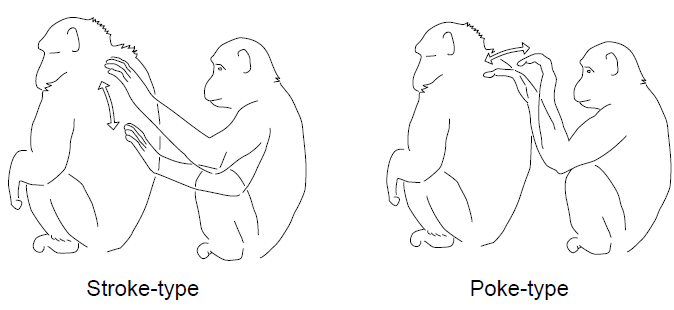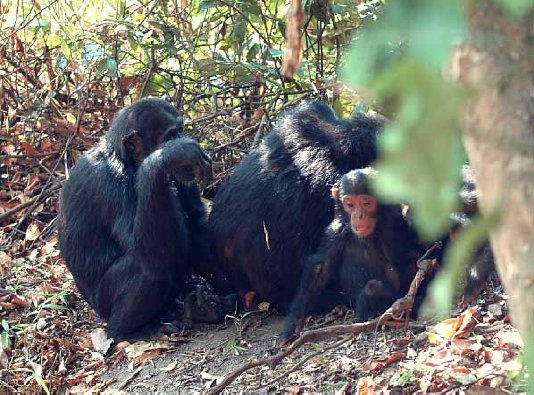|
<NOTE>
Poke-type Social Scratching Persists at Mahale
Michio Nakamura
Wildlife Research Center, Kyoto University, Japan INTRODUCTION
Social scratch is a grooming pattern observed consistently in Mahale, whereby one individual scratches the body of another individual1. A different type of social scratch is customarily observed at Ngogo2. Mahale chimpanzees employ stroke-type scratching, whereas Ngogo chimpanzees employ poke-type scratching2 (Figure 1). Although Shimada3 reported that three Gombe chimpanzees performed social scratch, there are no reports of this behavior from other study sites.

Figure 1. Two types of social scratch: stroke-type and poke-type. Although the dominant type of social scratching at Mahale is the stroke-type, one adult female Ako showed the poke-type scratch2,4: According to Nishida et al.4, Ako was first seen to show this pattern in 1999, used both types equally (8 pokes vs 7 strokes) between 2002 and 2003, and ceased to show the poke-type in 2004. Nishida et al.4 also stated that there was no evidence of social transmission in the different types of social scratch, because Ako’s daughter Acadia never showed the poke-type.
However, I observed several cases of poke-type social scratching by Ako and Acadia after 2004, as reported here.
Between November 2005 and July 2010, I made 9 short visits to Mahale (each visit consists of about one to two months), during which I saw 22 cases of social scratch by Ako (Figure 2). Twelve of them were the poke-type and 10 were the stroke-type (Table 1). Although the data-set is small, it seems Ako has not changed her social scratching types over the years. On September 24, 2008, she showed 4 cases of poke-type and 4 cases of stroke-type intermittently within 10 min, directed to the same adult female Abi. Thus, Ako mixed both types even in the same grooming session.

Figure 2. Ako (left) just after performing the poke-type scratch. Ako’s son, Agano, sits in front. I saw her show the poke-type during my last visit, in 2010. In the same study period from 2005, I observed 9 cases of social scratch by Ako’s daughter Acadia. Acadia was the first offspring born to Ako in 1998; thus, she was in transition from juvenility to adolescence during my study period. She showed the poke-type twice and the stroke-type 7 times (Table 1). Although Acadia’s poke-type was first seen only in 2006 (in the same day), it is difficult to say whether or not she changed her type because she showed the stroke-type before and after 2006. Acadia was last seen by observers in September 2009, and because she had started to show adolescent estrous swelling and was in good health, it was assumed that she emigrated to another group.
Ako also has a son, Agano, born in 2004, but he was not seen to perform social scratching during the study period.
DISCUSSION Contrary to the report by Nishida et al.4, Ako did not cease the poke-type social scratch in 2004 but instead she continues to use both types equally. It is puzzling why she did not show any poke-type scratching in 2004, but it might be an observational bias, as she has kept showing this pattern every year, except for 2007. So, the poke-type scratch still survived in Mahale’s M group. It is notable that Ako’s daughter Acadia showed, although only twice, the same poke-type scratch. As so few individuals showed the poke-type scratch at Mahale4, I suspect that Acadia somehow copied this pattern from her mother, the most frequent performer of the pattern, rather than surmise that Acadia invented this pattern by herself. Unfortunately, we cannot do a follow-up study of whether or not Acadia continues to use the poke-type, as she has emigrated.
As of 2010, I have not observed Agano, Ako’s son, performing social scratching. This is partly due to his young age and partly due to short observation periods, so he is not yet observed to groom others often. He should start soon to groom others, and perhaps he will show more social scratching when he enters adolescence. It will be interesting to see whether or not he will employ the poke-type in the near future, as he had many chances to watch his mother doing the pattern and he also sometimes received the poke-type scratch from Ako.
Back to Contents |
